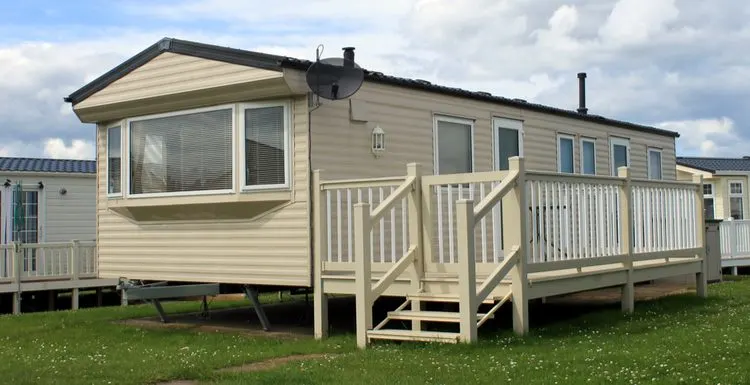Mobile home skirting is one of the finishing touches on your home that will bring the whole design together.
The right mobile home skirting will make your home look polished and presentable. Choosing the best skirting for your home is easy and doesn’t have to break the bank.
This guide will cover the basics of mobile home skirting. We’ll be discussing design options, sharing inspiration to help bring your ideas to life, and showcasing a variety of materials to match a wide range of styles.
What Is Mobile Home Skirting?
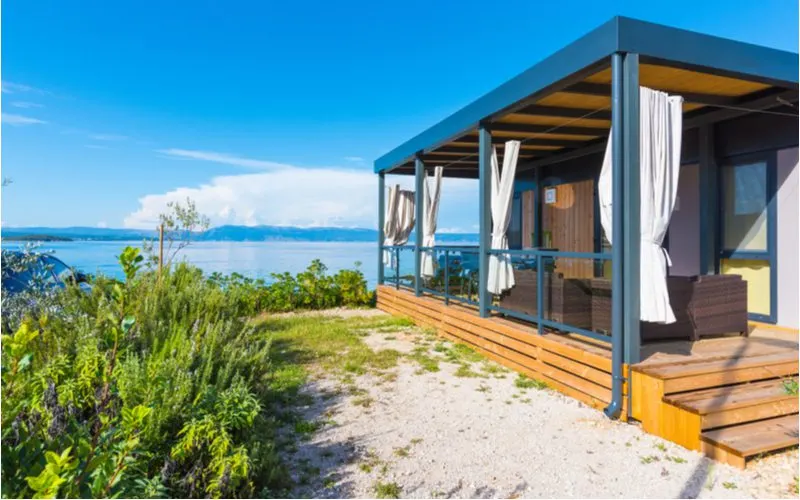
Anna Kwiatkowska/Shutterstock
What exactly is mobile home skirting, and why should you consider it for your home?
Mobile home skirting, also sometimes known as “underpinning,” is the material used as a barrier to surround the open space around the undercarriage of a mobile home.
There are a few main reasons to ensure that your mobile home has the appropriate skirting. We’ll dive into each of these and give you a few things to consider below.
Improved Curb Appeal
A mobile home is known for its ability to be easily relocated from one lot to another, and this modular design relies heavily on the structural elements underneath the home.
While a traditional home would have plumbing and a permanent foundation underneath it, the mobile home does not. The home will rely on blocks for a foundation with a vapor barrier underneath to protect the building from water damage.
Your neighbors don’t want to see this. The skirting creates a visual wall, blocking the view underneath the home. The result is a home that, at first glance, looks like it is sitting directly on the ground.
No Critters Allowed
Nobody wants a surprise pet raccoon taking residence in the cozy corners of their mobile home’s undercarriage. Properly installed skirting will prevent fuzzy new friends from burrowing under the home.
Snakes, opossums, and other unwelcome pests will have to move along and find some other place with free rent. Your home won’t be one of them!
Protection from the Elements
The right mobile home skirting will also help with the maintenance of the home. Pipes will freeze when exposed to harsh winters.
Skirting can help reduce the chances of this maintenance disaster by insulating the undercarriage of the mobile home and preventing the pipes from being exposed to freezing temperatures.
Creates a Cozy Winter Fortress and a Cool Summer Retreat
Manufactured homes used to get a bad rap for being less comfortable than a traditionally constructed home. Not anymore! Chilly winter storms will be no match for the coziness of your mobile home, with the right skirting retaining heat.
The same skirting will keep a nice shade with a consistent temperature underneath the building in the summer. Proper insulation will make a big difference in your energy bill, too.
Bonus Storage Space
The crawl space underneath a mobile home can be instantly transformed into extra storage space with the right skirting.
Use waterproof tubs to store seasonal decorations, yard tools, and other home goods you might traditionally store in a shed right underneath your home.
A Finished Look
Mobile doesn’t have to be temporary. Investing in skirting will help make a manufactured house feel like home.
A great path to doing this is to create a yard that is captivating and timeless—a tactic that says this home is here to stay. Adding the right mobile home skirting is the perfect backdrop for a well-manicured landscaping design.
Complying with Local Regulations
In some places, it might even be legally mandated that your home have proper skirting.
Whether it’s the local law or simply the neighborhood homeowner’s association’s rule, installing skirting on your mobile home may be necessary to remain in good compliance.
Types of Mobile Home Skirting
There are a variety of styles, designs, and materials to choose from for your mobile home skirting.
Vinyl Skirting
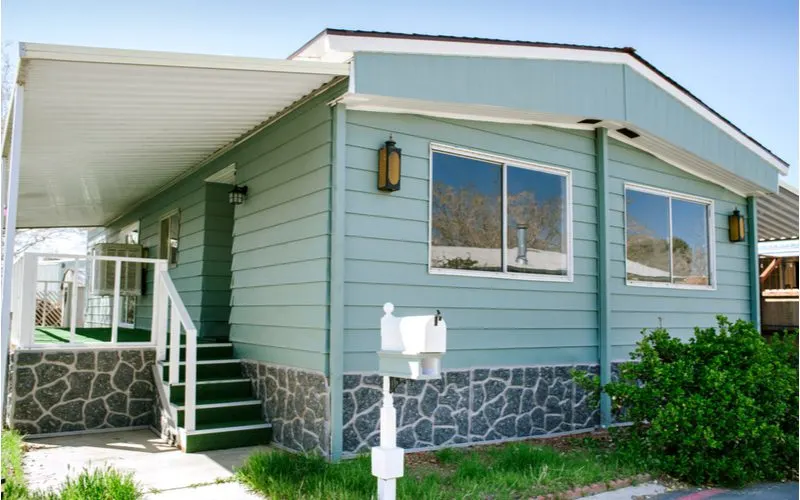
Agil73/Shutterstock
Vinyl mobile home skirting is one of the most cost-effective options on the market, and because of this, it also tends to be one of the most common. Not only is it cost-effective, but it also comes in many unique designs.
It also has a great appearance, which, combined with its durability and price, makes it an obvious front-runner when shopping for skirting. This skirting style is also easy to install, which makes for lower labor costs too.
Vinyl skirting consists of four parts: the panels, a ground track, the top back, and the top front. You can usually purchase these panels in 12-foot segments, which are then customized to fit the home, such as being cut to suit any angles if built on a hill.
Metal or Tin Skirting
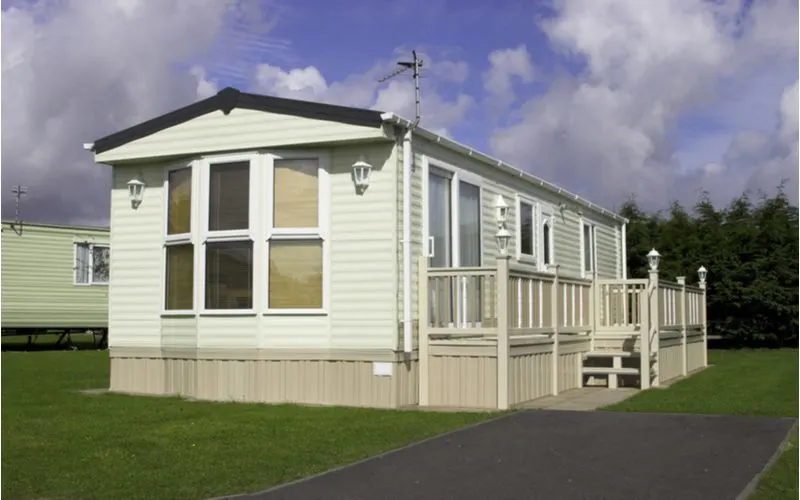
Mark William Richardson/Shutterstock
Tin, steel, and other metals are popular options for skirting. The appearance is a classic look, and the cost of materials is also competitively low.
This skirting option generally comes in pre-framed sheets that are either 2×2 or 2×4 and are then attached to lumber to help with durability and installation.
One reason this is a popular design is due to the options for customization of sheet metal. Patterns and trendy details can be stamped right into the metal, adding to the home’s curb appeal and unique appearance.
This option doesn’t require painting, which minimizes upkeep, but it does have the option of being painted if you want to update the look later.
Concrete
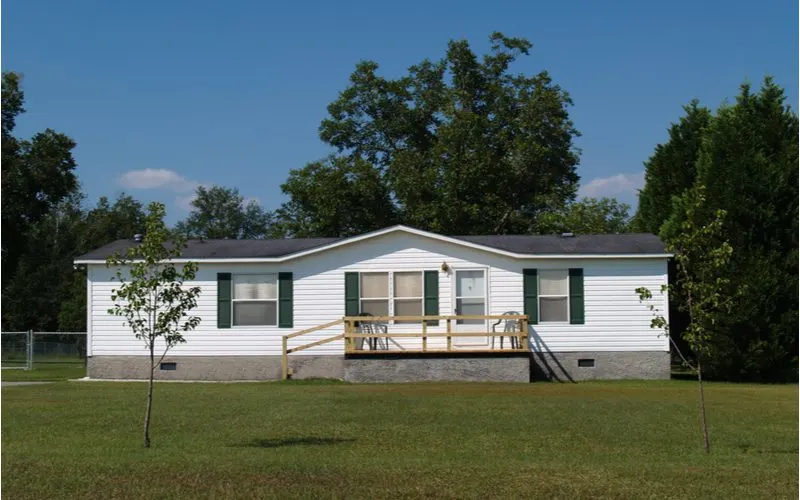
Lindasj22/Shutterstock
Concrete is an excellent skirting option for manufactured homes that are being built on a lot where they will be for a longer period of time.
There is a pouring option that creates a perimeter support wall, and there are also products on the market that create slabs of concrete that can be used to build a wall.
The concrete slabs have a design built in that helps create the necessary ventilation for a mobile home undercarriage while still preventing spaces where rodents and other pests can enter. One of the main selling points of concrete is its long-lasting durability.
Brick
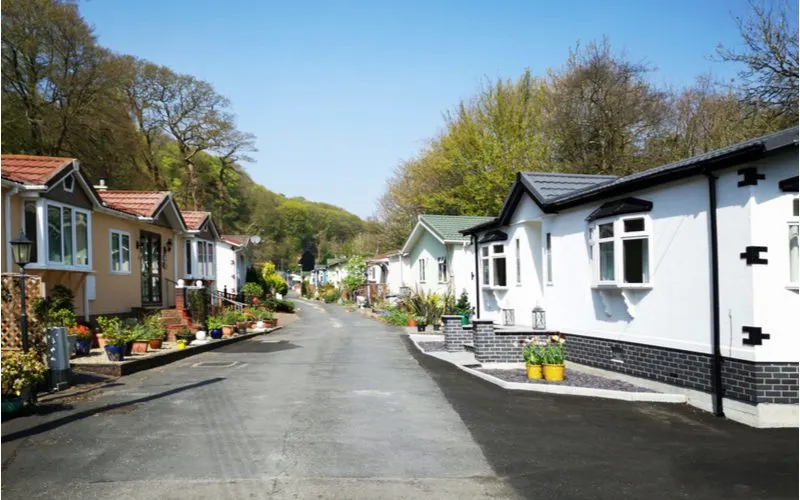
Jax10289/Shutterstock
Another reliable and sturdy skirting option is standard brick. This is one of the more permanent ways to go, so it will require some extra steps, such as digging a foundation and then pouring a concrete base.
Once the base is prepared, the bricks can be laid accordingly. The look is classic and can help make a mobile home look much more like a traditional home.
The permanent brick option removes the mobility of the home, however, so there are increasingly more options available on the market for faux-brick panels and brick veneers.
These can be stamped metal or other materials, so you can choose which material is best for your location. Similar to brick and concrete, cinder blocks are a permanent option for mobile home skirting.
They can be pretty durable and last for years. These also have stamped options for more mobile-home-friendly alternatives.
Foam Skirting (or Insulated Vinyl Skirting)
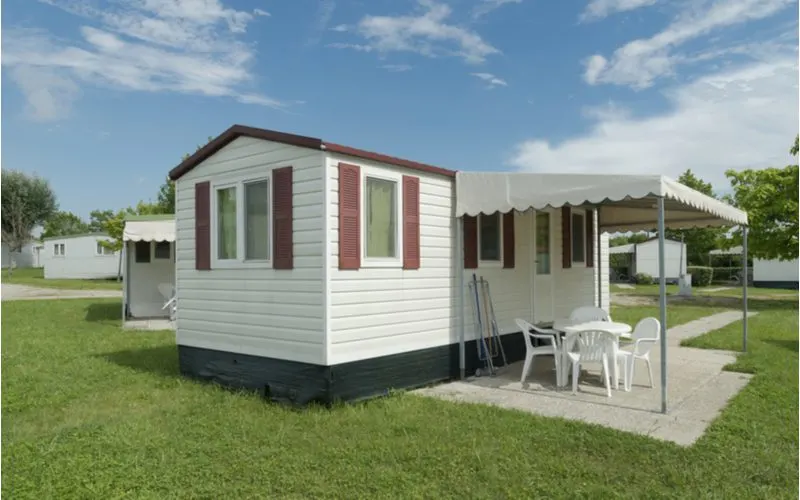
Hans Engbers/Shutterstock
When insulation is a priority, foam board can be an excellent option for skirting. These manufactured skirting materials are about an inch thick and are designed with energy efficiency in mind.
Made in combination with vinyl, these boards are flame-retardant, don’t scratch or dent, and don’t require extra framing or foundation setting.
One design option that is common for foam skirting has a faux rock design and comes in a variety of colors.
Plywood, OSB (Oriented Strand Board), or t-111 Skirting
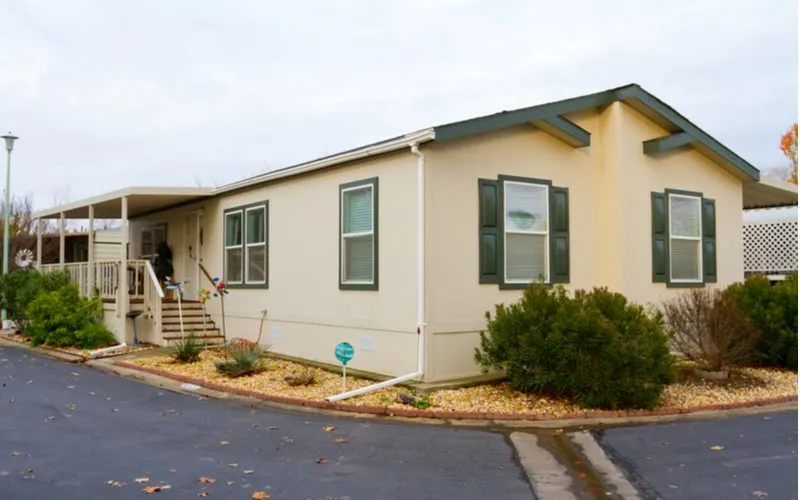
Joshua Rainey Photography/Shutterstock
One of the best options for a do-it-yourself skirting project is plywood.
This cost-effective material is also highly customizable, and there are many guides online that teach precisely how to do it, making it accessible even for a beginner to home improvement.
Things to Consider
As you decide which mobile home skirting option is right for you, here are a few additional details to consider:
How Long Will You Keep Your Mobile Home in One Location?
Homes of all types require maintenance, and mobile homes are no exception. Skirting materials can last 5–15 years, depending on the location of your home and how the weather and elements will interact with the skirting.
High-impact weather, like extreme temperatures and storms, may cause the skirting to degrade faster.
Because of this, you should consider the home’s location when deciding whether to purchase skirting based on the aesthetic appeal versus durability. The more durable options, such as brick and concrete, are great options for lasting through weather and wear.
However, another consideration should be how long the mobile home is intended to stay at that one location. The durable skirting option might be too permanent and a drawback from the benefits of the mobility of a mobile home.
Local Regulations
State law zoning ordinances and homeowner associations alike can have specific regulations surrounding mobile home skirting.
It’s essential to research your local regulations because looking around at how other people have done things in your neighborhood can’t always be reliable since not everyone will pay attention to or enforce the rules.
HUD loans (Department of Housing and Urban Development), also known as FHA loans, require that mobile homes comply with these basic requirements:
- Permanent wall to enclose the foundation
- Self-supporting
- Rest on a concrete footing
- Have access opening
Conduct local research to see which rules apply to your mobile home.
Installation Kits
A handful of companies sell skirting kits, taking the guesswork out of determining what materials will be necessary to install skirting in your mobile home. However, these kits come at a higher price because you’re paying for that convenience.
If you’re looking to save money, take the time to measure your mobile home and create a shopping list for all the screws, planks, and tools that you will need.
Other Benefits
- Installing mobile home skirting might help you qualify for lower home insurance payments.
- Mobile home skirting helps with moisture control under the home, which helps with mold prevention.
- The reduction of wind exposure is a great reason to install mobile home skirting, lowering noise pollution and regulating the temperature inside the home.
Trailer Skirting FAQ
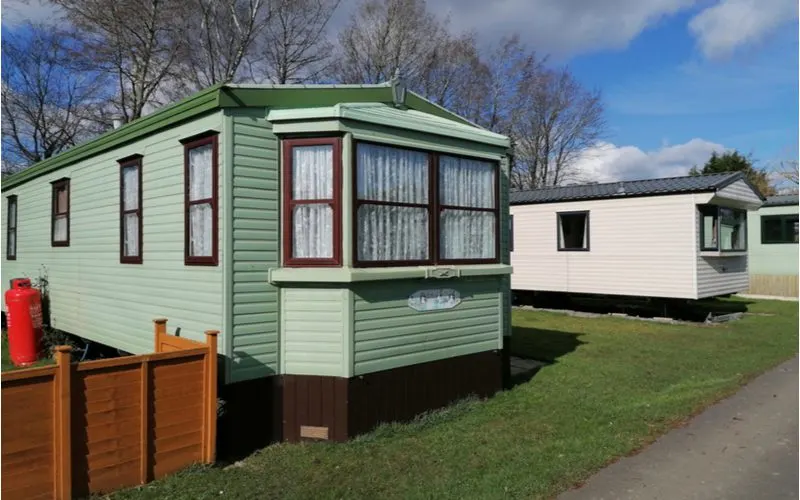
Sahakarn Puttarnu/Shutterstock
Here are some of the most common questions people ask about mobile home skirting.
How Do I Determine How Much Skirting I am Going to Need?
Before purchasing materials to install your mobile home skirting, you’ll need to calculate how much you’ll need to buy. Use this simple measurement tool to figure out the amount necessary.
First, find the average height. Do this by measuring the height of the space between the ground and the bottom of the mobile home, taking down the measurements at every corner as well as at the center of each long side.
Then, add each of these numbers together and divide by six. Add one inch, rounding up. There are also helpful online calculators you can use to help you create your estimate.
How Much Does Mobile Home Skirting Cost?
The cost of the materials ranges based on quality and type. As we’ve discussed, Vinyl skirting is more cost-effective, at around $400-1,300 for materials to place a skirt around a single-wide mobile home. Insulated vinyl skirting will be notably higher, at $1,400-3,800 for a single-wide.
Faux rock, stone, or brick skirting will range from $700-2,400 for a single-wide. If you want to install concrete, brick, or cinder blocks, seek a local estimate, as prices vary based on region.
The cost of a handyman to perform the installation is usually about $50 an hour, or under $500 for a day. Don’t forget to take into consideration the cost for tools and other pieces necessary for installation, plus access doors and ventilation.
How Do I Get Access to My Home’s Undercarriage?
When you install the skirting, be sure to take note of the spots you may want to have regular access to, such as locations where you have pipes for plumbing in case you need to perform repairs.
Small access doors are an essential addition to the skirting, so you don’t have to cut into the brand new skirting just to address maintenance issues.
Where Do I Purchase Mobile Home Skirting?
Big home improvement box stores are a great place to start when you’re looking for a DIY skirting solution.
You can often find installation deals and contractors’ details at these home improvements stores as well. Another helpful resource is The Factory Build Owners of America.
Can I Install Skirting Myself, or Should I Hire a Professional?
Doing your own installation of your mobile home skirting is a great way to save money. Many how-to guides and step-by-step instructional videos on the internet will teach you exactly how to install your skirting.
However, if you’re not sure what you’re doing when it comes to a specific kind of skirting material, it may be best to leave it up to the experts to give it that polished look.
What’s the Most Important Factor in Deciding Which Skirting is Right for My Home?
Some might say that the cost of the type of skirting you’re selecting is the most critical decision to make for this project. However, it is essential to consider if that material is actually right for your region.
For example, some areas are prone to storms and heavy rainfall, and because of this, wood skirting might not be the best option as it is known to rot more quickly than other synthetic materials.
So, What Is Mobile Home Skirting?
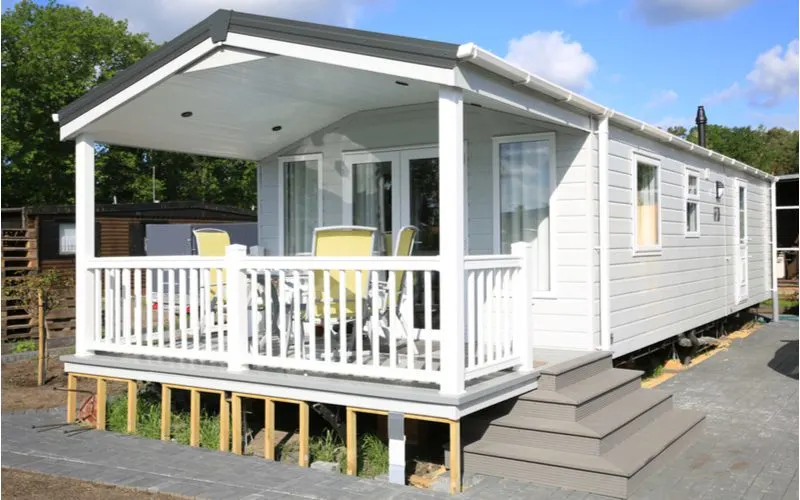
Traveller70/Shutterstock
Mobile home skirting is a common and often necessary part of living in manufactured housing.
To have the polished and put-together look you’re after for your home’s exterior design, consider the variety of materials available to install skirting on your home.
Beyond design, consider the elements and needs related to your home to maximize which selection is right for you. So, the only question that remains is, “Which trailer skirting will you choose?”

